#estoire del saint graal
Explore tagged Tumblr posts
Text
QRV - History of the Holy Grail 2-3
preface | intro pt 1 | intro pt 2 | HHG 1
With the preamble framing device established, the History begins with the death of Jesus and the role of Joseph of Arimathea. Joseph collects the cup used for the last supper from the house where the last supper happened, and then pulls the body down and collects the blood in the cup. (I'm guessing the cup becomes the Grail.) He then wraps Jesus's body up and lays it in a grave, then sticks the cup full of blood in a special place of honor in his house.
And…. welp, Anonymous gets a bit antisemitic in this section. (This is the challenge of medieval literature, unfortunately - it's not great about religion, race, ethnicity, sexuality, or gender, even when it's better about it than you'd expect.)
(If you want non-antisemitic medlit, try the Hebrew text Melekh Artus/ King Artus if you can find a copy, or the 1789 Yiddesh text Gabein.) Let's just say that Joseph is captured, placed in Caiaphus's stronghold prison and not given any food or water for the next 42 years. The apparition of Jesus visits him along with the Grail cup full of blood (…ew?).
Meanwhile, his wife refuses to remarry until she knows for sure that her husband is dead (Penelope vibes), and raises their son Josephus who "was so in love with Jesus Christ because of his mother's guidance that he said he would never marry any other but Holy Church" because… piety and purity, or something.
(Buckle up. There's gonna be a lot of this any time the Grail comes up. It'll mostly stop when we're out of the Grail content. This is one of several reasons I always skip the History of the Holy Grail when reading through the Vulgate.)
Anyway. That brings us to section 3, where we get a history lesson in the succession of Roman emperors, and Emperor Titus's son Vespasian has leprosy, making the emperor very upset. They're searching for a cure, and eventually they find someone talking about being cured by Jesus, and go hunting for something that Jesus touched.
A knight (from Capernaum - apparently a fishing village on the sea of Galilee had knights in 75 CE. knights in that region/era sure is news to me) is the one who brought up the idea, and manages to find an elderly woman with a cloth that Jesus wiped his face with at some point. It's got an imprint of his face on it, because Catholicism. Sure enough, it works and heals Vespasian of leprosy and he becomes a fanatic, travels to Jerusalem and decides he's going to burn everyone who had a role in the death of Jesus (this is where the antisemitism really shows up; I'm not gonna repeat those parts here).
So then he threatens people until he finds out where Joseph of Arimathea was stashed. Turns out only a weekend has passed for him over the past 42 years, and he hasn't aged at all. So he doesn't recognize his wife or son, of course. Eventually it's all sorted out.
Vespasian goes back to Rome. Joseph gets a vision that he's supposed to go evangelize outside of Jerusalem and is never going to return. Also he's supposed to have more kids because Josephus took a vow of chastity and can't continue the line of Joseph of Arimathea. (I assume this is eventually going to lead us to Britain somehow, but it'll probably take a while to get there.)
#qrv#queer reading of the vulgate#history of the holy grail#estoire del saint graal#vulgate cycle#arthurian literature#arthuriana#arthurian newbie
2 notes
·
View notes
Text
Fate Grand Order Servant Comparisons
Gareth

Left - FGO
Right - Estoire del Saint Graal, La Queste del Saint Graal, Morte Artu
7 notes
·
View notes
Text

an illuminated manuscript from the Estoire del Saint Graal, France (Royal MS 14 E III c. 1315 – 1325 AD. Courtesy of http://britishlibrary.typepad.co.uk/)
from https://sites.dartmouth.edu/ancientbooks/2016/05/24/medieval-book-production-and-monastic-life/
0 notes
Photo

Sir Galahad wounding Sir Gawain in a tournament he has entered, in defense of knights of a castle unable to hold their own against a visiting party, Estoire del Saint Graal, La Queste del Saint Graal, Morte Artu, Royal MS 14 EIII, f. 125r, C. 1315-1325, France, The British Library
Source: The British Library
#sir galahad#sir gawain#knights of the round table#tournament#estoire del saint graal#morte artu#the british library#france#illuminated manuscript#manuscript#14th century
38 notes
·
View notes
Text
FEEDBACK LOOP #6: Cargo Cults’ “Rammellzee”

Since these symbols and all symbols are drawn, infinity’s separation from all symbols must be shown through drawing. The only proof of such a separation of the infinity would be the understanding by the majority of the planetary peers. There is no other way.
—from IONIC TREATISE GOTHIC FUTURISM ASSASSIN KNOWLEDGES OF THE REMANIPULATED SQUARE POINT’S ONE TO 720° TO 1440° THE RAMM-ΣLL-ZΣΣ (1979, 2003)
The rabbit-hole went straight on like a tunnel for some way, and then dipped suddenly down, so suddenly that Alice had not a moment to think about stopping herself before she found herself falling down a very deep well.
—from Lewis Carroll’s Alice in Wonderland
Riding among an exhausted busful of Negroes going on to graveyard shifts all over the city, she saw scratched on the back of a seat, shining for her in the brilliant smoky interior, the post horn with the legend DEATH. But unlike WASTE, somebody had troubled to write in, in pencil: DON’T EVER ANTAGONIZE THE HORN.
—from Thomas Pynchon’s The Crying of Lot 49
1. I walk down the street and people look at me and say, “Who the hell are you?”
Cargo Cults (Alaska and Zilla Rocca) begin their track “Rammellzee” with the voice of the some-16 billion-years-old being himself. The song is an ode, an invocation. The organ sample provides a bizarre ride: a carousel of colors. We immediately plummet—into a well, a subway tunnel, a cosmos of linguistics. Not a nonchalant That’s deep, but a depth of knowledge where “cipher” means code, means Supreme Mathematics, means gathering with your rapfolk outside the Nuyorican Poets Cafe or in Washington Square Park: a deep connection. Mimicking Rammellzee, Alaska presents the listener with “swirling pages / forming mazes of [his] formulations” and subsequently “break[s] them down into a form that’s shapeless.”
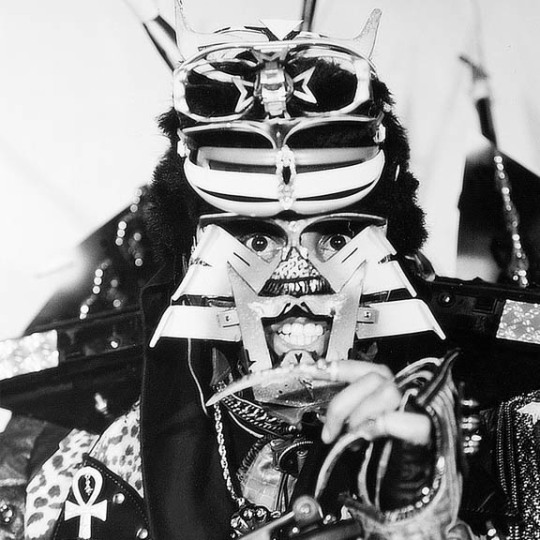
2. Hip-hop is ageist….In blues, you ain’t official until you fifty. (Ka, Red Bull Music Academy interview with Jeff Mao, 2016)
The phrase …of a certain age has, historically, been used euphemistically to describe someone (typically a woman) who has existed for a “shameful” tally of years. Society is still undoing the stigma, but rappers have made strides.
In Adult Rappers, a 2015 documentary directed by Paul Iannacchino (Hangar 18’s DJ paWL), Alaska is [accidentally?] presented twice in the closing credits—like a double, a separate persona—which calls to mind the multiple personalities of Rammellzee: Crux the Monk, Chaser the Eraser, Gash/Olear, et cetera. Age allows for maturation, for building, for bettering. In Rammellzee’s case—and I’d argue Alaska’s—it allows for complexity to emerge organically through wisdom. It allows for reinvention, for many versions of one’s self. Age and development is how an aerosol can with a fat cap can graduate to customized deodorant roll-ons and shoe polish canisters.
It begins with jerry-rigging a nozzle and ends in diagramming a “harpoonic whip launcher/pulsating extendor” to illustrate the deconstruction of letter-formations in the English alphabet. The spirit of experience pervades the Nihilist Millennial album. As anyone who has ever sat on the couch knows, communication can also improve with age.

3.
Artists and rappers like Rammellzee and Alaska rely on wild-styles, a self-made world that warps quantum physics and disregards notions of dimensionality. It’s dream-vision. It’s liberation. It simultaneously celebrates and critiques communication: like the image of a muted horn.
“Communication is the key,” cried Nefastis. “The Demon passes his data on to the sensitive, and the sensitive must reply in kind. There are untold billions of molecules in that box. The Demon collects data on each and every one. At some deep psychic level he must get through…”
“Help,” said Oedipa, “you’re not reaching me.”
“Entropy is a figure of speech, then,” sighed Nefastis, “a metaphor. It connects the world of thermodynamics to the world of information flow. The Machine uses both. The Demon makes the metaphor not only verbally graceful, but also objectively true.”
[…]
Nefastis smiled; impenetrable, calm, a believer.
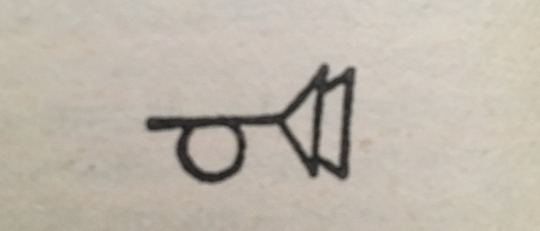
The wordplay seems just that: play—that is, until you find the thread. Alaska cobbles together words like rubbish, W.A.S.T.E. Words appear daisy-chained together—flowery, ornate, and strung together by their stems: “fatalism, Fela Kuti, razor thin” / “smash the superstitions with acid tabs and some Sufi visions” / “deep dive Sonny Liston” / “Walt Whitman.”
The track reads like a codex. Something crafted in a scriptorium. His words are warfare—double-tracked/double-barreled—and he slips into braggadocio to prove it. It’s an authoritative posture of experience. Having started atomically small—from Breaking Atoms bedroom listening, to Atoms Family—Alaska’s flow presents nuclear now: maximum damage.
There’s a refinement to what this duo is doing: “Me and Zilla well-established with a lavish vision. / Both hands crusty with Ikonklastic Panzerism.” The boasts rely on royal diction: Camelot, palace doors, Prince Paul. Each man a king, a God, and each one should teach one. Mentor texts for the masses.
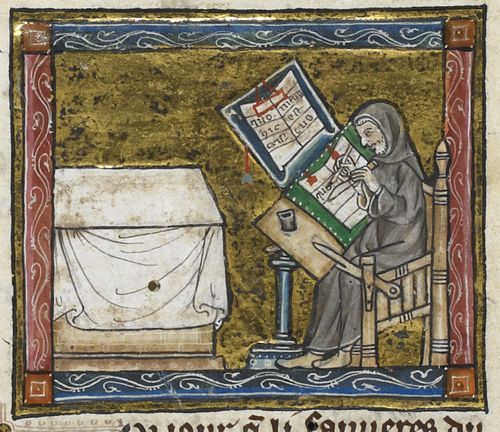
4.
Rammellzee is an equation, And simply stated it’s the way of life I’m chasing. That’s why I praise the future-Gothic future-prophet. Gotta rock it, don’t stop it, Gotta rock it, don’t stop.
You find diversions on the song, exits into familiar chambers. GZA quotations (“I was the thrilla in the Ali-Frazier Manila”) and allusions to Main Source. Large Professor rapped “Dead is my antonym,” and if that’s to be proven true, money needs to be removed from the equation. The refrain of “Gotta rock it” not only calls to mind “Beat Bop,” Herbie Hancock, and Grand Mixer DS.T (or his later incarnation, DXT), but rockets—Afrofuturist angles, future shocks (Bill Laswell [Material], friend to Rammellzee, had a hand in all this). It’s not so much a “future-prophet” as a “future profit.” “Freedom in the process” means creativity without expectation, without the constraints of market value.

Alaska gives it to us straight: “I don’t care if you don’t like it, and I don’t care if you don’t buy it / ’Cause I find freedom in the process.” Despite becoming increasingly complex in his visual approach—like a heap of garbage that loses the definition of its component parts over the ages—Rammellzee understood time equals clarity of vision. A wasted world becomes a meaningful one. Of course, we got to pay rent, so money connects, but ownership of one’s art is about empowerment. “Selling out” is the opposite—an evisceration of one’s self and spirit. “We lost control from the second we sold the art,” Alaska raps. “We sold our future….We should be seeking enlightenment.”
The moment arrives, epiphanically: “I find freedom in the process so I’m grateful, / And that’s my main source: it’s my friendly game of baseball.” For Alaska and Zilla Rocca, it’s not a job—it’s a passion, a pastime.
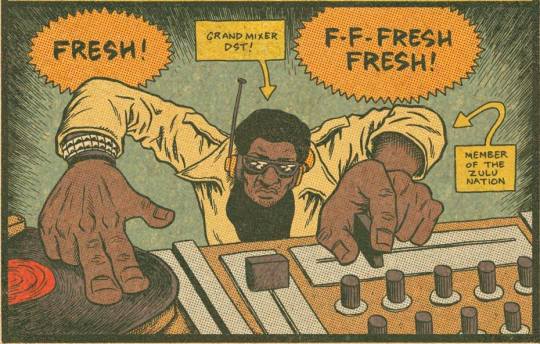
5. Nascent imagination deep inside a battle station.
Post-9/11 meant luxury apartments displaced Rammellzee’s Battle Station loft, his living museum. But the art has been excavated and exists posthumously. His Gothic Futurism and Ikonoklast Panzerism seem at home archived on the internet—a network that appears more like a chaos cloud. Rammellzee deconstructed and transcended language—junk monk scripts and calligraphic cut-ups of consumerism. His art is the empowerment a recycling arrow-triangle could only hope to be. Recycle is also rebirth. Rammellzee’s career path is circuitous, deep-tunneled (subway-esque), eternal.
Similarly, Alaska’s multisyllabic patterns are an endless barrage, like weaponized letters tilted sideways, like bottle rockets angled into a bottle’s neck: “Armament / Now my names are built like a BattleBot / Locked inside an ad hoc Camelot, I rather not / Tangle with a rabid lot, hop inside a rabbit hole.”
Alice was beginning to get very tired of sitting by her sister on the bank, and of having nothing to do: once or twice she had peeped into the book her sister was reading, but it had no pictures or conversations in it, “and what is the use of a book,” thought Alice “without pictures or conversations?”
Boredom can make trouble, but boredom can also breed creativity. Alaska rather not spar with trolls under ISP bridges—though he’s equipped to. Instead, he channels his energies into material.

6. Our culture is done. We lived it.
Near the end, Alaska paraphrases Rammellzee: “I’m not the first or the last to don the mask. / I see it as a title, I’m monastic with these raps.”
Living a life of art—making it regardless of accolade or monetary payment—is the highest form of creativity. Live the art and die by it, like Stan Brakhage, poisoning himself at a slow pace as he applied toxic dyes to celluloid film. Like Rammellzee executing graffiti pieces maskless, huffing the carcinogenic fumes.
MF DOOM (née Zev Love X)—a Rammellzee descendant—taught us how to revel in anonymity, the importance of not spotlighting yourself, but instead seeking out the shade, secret passageways, and the trapdoor in the stage floor. Not all of us heed the advice, but some do, and they feel the throb of real success, not the sort that shows up in bank statements and 401(k) plans.

Images:
“Beat Bop” test pressing, Rammellzee and K-Rob, art by Jean-Michel Basquiat, 1983 (detail) | Rammellzee black-and-white portrait photograph (unknown) | Ikonoklast Panzerism diagram from IONIC TREATISE GOTHIC FUTURISM ASSASSIN KNOWLEDGES OF THE REMANIPULATED SQUARE POINT’S ONE TO 720° TO 1440° THE RAMM-ΣLL-ZΣΣ (1979, 2003) | Page 34 (muted post horn) in Thomas Pynchon’s The Crying of Lot 49, Bantam Books edition (1966) | “A scribe at work,” from an illuminated manuscript from the Estoire del Saint Graal, France (Royal MS 14 E III c. 1315-1325 AD) | Herbie Hancock, Future Shock cassette cover (1983) | Grand Mixer D.ST comic book image (unknown) | Stan Brahage at chalkboard (unknown) | Stan Brakhage, Mothlight celluloid (1963) | “Beat Bop” test pressing, Rammellzee and K-Rob, art by Jean-Michel Basquiat, 1983 (detail)
2 notes
·
View notes
Photo

Estoire del Saint Graal, La Queste del Saint Graal, Morte Artu
The illustration shows Galahad drawing the sword from the marble block in front of Arthur and his court.
The king and his barons went down at once to see this marvel. When they came to the river bank, they found the great stone lying now by the water’s edge. Held fast in its red marble was a sword, superb in its beauty, with a pommel carved from a precious stone cunningly inlaid with letters of gold. The barons examined the inscription which read: NONE SHALL TAKE ME HENCE BUT HE AT WHOSE SIDE I AM TO HANG. AND HE SHALL BE THE BEST KNIGHT IN THE WORLD.
17 notes
·
View notes
Photo
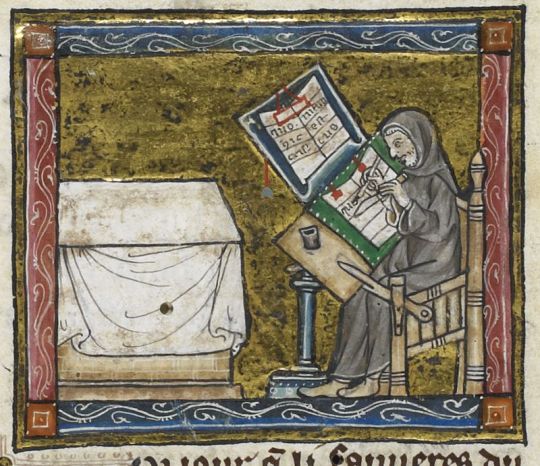
Detail of a miniature of a hermit at work on a manuscript, from the Estoire del Saint Graal, France (Saint-Omer or Tournai?), c. 1315 – 1325, Royal MS 14 E III, f. 6v (via Royal_ms_14_e_iii_f006v_detail) Link to the blog post The Burden of Writing: Scribes in Medieval Manuscripts at the Medieval manuscripts blog.
0 notes
Text
QRV - History of the Holy Grail 1
preface | intro pt 1 | intro pt 2
Here we go… History of the Holy Grail. The first section of the Vulgate Cycle. I don't know how closely I'll read this, to be honest. I might end up skimming. But I'm going to make an attempt.
We start out with…. a lot of religiosity. and then a lot of self-flagellating by the purported narrator. The "most sinful of all sinners," and "the most humble and despised person ever created," etc, etc.
Hehe. "I saw a man standing in front of me, so handsome and charming that his beauty could not be described by any mortal man's tongue." Now, see, beauty in these times was associated with virtuousness and was a literary shorthand for purity/goodness. So that's probably why the beauty is being emphasized, since apparently this is literally God who's appearing before the narrator.
But… I swear, the beauty of men gets enumerated in waaaay more detail throughout this book, whereas women's beauty is often "she was the most beautiful in the world" and that's about it. (Sometimes it gets expounded on, but not to the degree we'll see much later with, say, Lancelot.)
Still, this particular instance does seem to be the writer trying to convey an impression of divinity.
…anyway. After much pageantry and vision symbolism, the narrator receives a little book packed full of his lineage/ancestry, which he's very excited about for some reason. And then eventually it says, "The book of the Holy Grail begins here."
…More pageantry, visions, angels, etc. Narrator locks little book up in a box. Narrator opens chest to read and the book is gone. Narrator is told they'll undergo great difficulties before they see the book again, go on a quest to… Norwegia?? Norway???
(Oh. A footnote mentions that it was a territory in Scotland occupied by Vikings at the time. "Western part of the country north of the Clyde and the islands.")
But on the way to … Norwegia, the narrator encounters a variegated beast that sounds to me like the Questing Beast. So he follows it to a hermitage, blesses a hermit though he's upset because "I was a sinful man and thus could not give (my blessing)" (narrator has abysmal self-esteem).
Questing Beast (?) returns! More fantastical symbolism all along the way, and random knight encounters. It all feels very dreamlike and surreal. I think this is all preamble still?
There's a brief weird exorcism (involving the narrator finding his little book in a chapel and using that to exorcise a devil), and the narrator takes care of the victim for a while afterwards at the chapel where he found him. Questing Beast (?) returns again, and the exorcism subject is the first person other than the narrator who can see the Questing Beast.
Narrator has a vision that he's supposed to copy the book, and that's when the History actually begins. So this whole thing has been a framing device for the History of the Holy Grail, got it.
#qrv#queer reading of the vulgate#vulgate cycle#history of the holy grail#Estoire del Saint Graal#arthurian literature#arthuriana#arthurian newbie#that's the tag I've been using for my arthurian lit readthrough anyway
1 note
·
View note
Text
Queer Reading of the Vulgate Cycle pt 1: Preface
preface | intro pt 1 | intro pt 2
Some context on 1. this readthrough and 2. the Vulgate Cycle in general!
I've read large chunks of the Vulgate Cycle all out of order, sporadically, but I haven't read it from cover-to-cover yet. I want to remedy that, though I want to read it through a queer lens. (Also a trauma psychology lens, but I don't have a good shorthand term for that.)
The Vulgate Cycle (aka the Lancelot-Grail Cycle, the Prose Lancelot, or the Pseudo-Map Cycle) is an Arthurian romance composed between 1215 and 1235-ish, by Anonymous. Who may have been one person, but more likely was multiple authors. (I'm in the "multiple authors" camp, I can see no other explanation for the dramatic tone shift of The Quest for the Holy Grail. Or the History of the Holy Grail, for that matter.)
It's a massive text. It attempts to "elaborate the full story of the Arthurian era and to set that era in a framework of universal history" (so writes Norris J. Lacy in the preface to the translation).
The History of the Holy Grail (originally the "Estoire del saint Graal") - actually one of the last sections to be written, even if its contents come first chronologically. Traces the early history of the Grail and Grail-keepers. Lots of Bible fanfic bits in this one. My least favorite section (I find it tedious and dull).
The Story of Merlin - also one of the last sections to be written. Focuses on Merlin and his role in Arthur's conception, birth, and coronation. Also focuses on Arthur's early days as king, and some of his early knights (young Orkney brothers!), and Arthur's early relationship with Guinevere (back when things were really good between them).
Lancelot Proper (aka Le Roman de Lancelot, Lancelot propre, or just "Lancelot du Lac") - Lancelot's life and adventures (and everyone else's adventures that end up vaguely connected to him) from birth until… right before the Grail quest. Divided into 3-6 parts by modern scholars (Lacy divides it into 6, so that's what I'll be going with).
The Quest for the Holy Grail (La Queste del saint Graal) - My second-least-favorite section; it's less tedious and dull than the History, but it's such a departure from the tone of the rest of the Vulgate Cycle, and it feels like a text designed to convert people to Christianity (and that may indeed have been its intended purpose). It's possible that the tone shift might be because each sectio nhad a different translator, but I don't think that explains it sufficiently.
The Death of Arthur (La Mort Artu) - the most readable section, imho, and probably my favorite. It promptly unravels all the purity nonsense that Quest put into place (feels like when a show gets a new showrunner for a season, and then the old showrunner gets the reins back a season later and is doing damage control on all the weird turns that the interim showrunner took), Lancelot and Guinevere get back together, and the story leaps into intense drama and beautiful tragedy.
Then there's the Post-Vulgate, which is basically just a grimdark and more religious rewrite of the Vulgate, minus the Lancelot Proper. Lots more Grail focus. I don't know if I'll do a readthrough of it or not.
The specific translation notes in the Preface are fascinating, and I highly recommend them (I love translation notes), but the most relevant bit is this:
"…the translators have tried to steer a middle course. Our primary concern was to present a reliable and readable text to modern readers, but we have also made an effort to retain a certain number of the stylistic features of the Old French romances, provided those features were reasonably compatible with the characteristics of modern English usage.
Lacy warns the reader that the History of the Holy Grail has "a convoluted, dense style" far more than most texts of the period. (It's so tedious, do not recommend.) "The author appears to be far more concerned with substance and symbolism… than with concision and grace." They've cleaned up the text in some places but overall kept the characteristics of the style. If this is the more accessible version, I would not want to read a literal direct translation. D:
Next up: Introduction (more translation notes) to the History of the Holy Grail.
#arthurian literature#queer reading of the vulgate#qrv#arthuriana#vulgate cycle#arthurian newbie#though I should probably change that tag to something else#it doesn't apply so much anymore#but it's my read-through-Arthurian-lit tag at the moment soooo
25 notes
·
View notes
Photo

Miniature of a knight riding away from a castle, watched by King Evalac, f.21 of Estoire del Saint Graal/Queste del Saint Graal/Mort Artu (the Lancelot-Grail or Vulgate Cycle), 1300-1325, The British Library
Source: https://www.europeana.eu/portal/en/record/9200397/BibliographicResource_3000126272640.html
#knight#medieval#illuminated manuscript#lancelot#king arthur#lancelot grail#arthurian legend#arthurian literature#knights of the round table#history#fourteenth century#the british library#vulgate cycle
25 notes
·
View notes